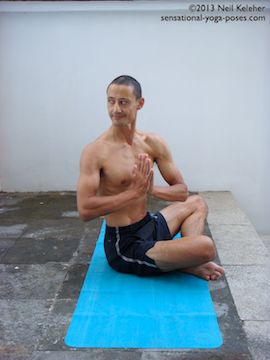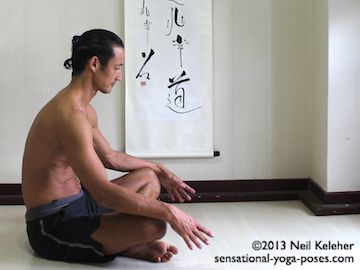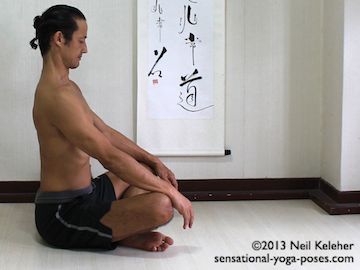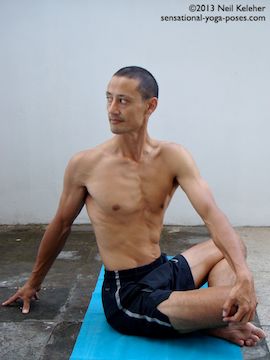Improving Thoracic Mobility and Awareness
On page cat links

One very simple way to improve thoracic mobility and awareness is with an exercise called "easy breathing."
On page cat links

One very simple way to improve thoracic mobility and awareness is with an exercise called "easy breathing."
Sit either cross legged on the floor or in a chair. Start by rolling your pelvis forwards and backwards while keeping your ribcage upright.
When rolling your pelvis forwards focus on feeling your pubic bone moving down and your tailbone lifting. You can also feel your sitting bones moving back and up, away from the floor.
When rolling your pelvis backwards you can focus on feeling your pubic bone moving away from the floor and your hip crests moving back. You can also feel your sitting bones moving down and forwards.
See if you can tilt backwards slow enough that it takes you seven seconds or more. Then do the same while rocking forwards.


Spend about a minute focused on feeling your pelvis as you rock it backwards and forwards.
Continue the same easy breathing movement but now focus on feeling your lumbar spine bending back and forwards. When you roll your pelvis forwards your lumbar spine will bend backwards so that your belly lengthens. When you roll your pelvis backwards your lumbar spine will bend forwards causing your sternum to move towards your pubic bone.
After about a minute of focusing on your lumbar spine, expand your awareness to feel your thoracic spine as well as your lumbar spine. Keeping your head level , as you tilt your pelvis forwards bend your thoracic and lumbar spine backwards to lengthen your belly and open your chest. As you tilt your pelvis backwards bend your spine forwards.
To help open your chest when you bend your spine backwards pull the back of your head back and up, away from your ribcage. When you bend your spine forwards allow your head to move forwards and down.
Pulling your head back and up helps to straighten and lengthen the cervical spine. If you do this movement slow enough you may be able to feel your cervical spine pushing the head upwards from below (like a stick pushing up on the bottom of your skull!) Because the cervical spine sits on top of the thoracic spine, as you straighten your neck your upper thoracic spine will also straighten causing the front of your ribcage to expand.
Again practice pulling your head up and back and see if you can notice your chest lifting at the same time. Try to get the feeling that these two actions, pulling the head back and up, and lifting the chest, happen together and help each other. Rather than forcing one action and the other, feel your neck and upper ribcage and allow them to move together naturally.
A large part of improving thoracic mobility includes learing to feel both your ribcage and your thoracic spine.
As you pull your head back and up allow the front of your ribcage to lift and expand. When you move your head forwards allow your chest to sink down.
One final note, the muscles at the front of your neck will also help in lifting your ribcage when you pull your head back and up. This can be a good way to prepare for headstand. Focus on feeling your cervical vertebrae both as you lengthen your neck and as you relax it. Once you are used to feeling the vertebrae of your neck focus on feeling your ribs and your thoracic spine. Notice how movements of the ribcage and thoracic spine affect the cervical spine.
For myself, the more I lift and open my chest the easier it is to lengthen my neck. And so the takeaway from this is that thoracic mobility is affected by cervical spine mobility.
Continue the same movement but as you bend your spine backwards focus on lifting and expanding the front of your ribcage. Allow your ribs to sink as you exhale.
Rather than stopping when you think your ribs are maximally lifted, focus on continuing to lift up as you inhale and then focus on continuing to drop your chest while exhaling. As you inhale, continually lift your ribs, and then continue to try to lift your ribs even beyond the end of your inhale. And then do the same while exhaling, focus on lowering your ribs or allow them to sink down.
Make both movements slow and smooth (about 7 seconds each.) Focusing on the rib lift will exercise the intercostal muscles. These are the muscles positioned between the ribs that help to move adjacent ribs relative to each other. The more you work at moving your ribcage, the easier it is to feel.
To help making opening your ribcage easier you can use your spinal erectors. These muscles run up and down the back of your spine. When they activate you'll notice a feeling of tension either side of your spine.
When first beginning to use them I'd suggest first focusing on feeling your pelvis rolling backwards and forwards. Then feel your lumbar spine bending backwards and forwards. Then, as you bend your lumbar spine backwards focus on activating the spinal erectors that work on your lumbar spine. Relax them as you bend your spine forwards. Once you've got the hang of this action, then expand your awareness to include your thoracic spine. Try to carry the contraction of your spinal erectors from your lumbar spine all the way up the back of your thoracic spine as you bend backwards.
Then relax as you bend forwards. The spinal erectors are another key element in improving thoracic mobility. The better you can feel them the easier it is to use them to help vary the shape of your ribcage.
The intercostals probably aren't classified as accessory breathing muscles, but, I just wanted to say "accessorize your breath."
These muscles are located between your ribs and you can learn to use them by focusing on lifting and expanding your ribcage each time your bend your spine backwards. Make easy breathing even easier by focusing on creating space between each set of ribs. Then relax your ribcage. Let gravity pull your ribs downward and your head forwards as you exhale.
Couch potatoes time. Try to relax your upper body completely at the end of each exhale. Notice the feeling of relaxation and then feel the change as you activate your muscles and bend your spine backwards while lifting and expanding your ribs at the same time.
Once you have a feel for all the parts of easy breathing in isolation try to make all movements smoothly fit together. Rather than lifting your chest and then lengthening your neck, try to do both movements together so that they help each other.
By bending your spine backwards and lifting your ribs you help to expand the volume of your lungs causing an inhale. By bending your spine forwards and collapsing your ribs your reduce the volume of your lungs causing an exhale.
You may find that if you do these movements slowly and smoothly the breath happens by itself. That's one of the reasons I call this "Easy Breathing". You are working on directly controlling the muscles that you breathe with (your respiratory muscles.)
To make your breathing smoother see if you can make your breathing movements smoother and more controlled.
Notice how expanding your ribcage causes you to inhale.
Notice how dropping your ribs causes you to exhale.
Read costal breathing for a variation of this breathing method
For information on breathing through the nose or mouth and other options please have a look at breathing basics.
Once you have the general feeling for easy breathing, you can keep the pelvis still. Instead focus just on moving the ribs and neck so that the focus is on thoracic mobility. Focus on expanding your ribcage and lengthening your neck. Then relax them. Repeat smoothly and slowly.
As an additional exercise, try to hold your neck long and your chest expanded. You may notice then that your belly moves as you breathe.
Generally after an introduction to ribcage awareness with easy breathing I like to continue developing and using thoracic awareness in twisting poses.


A very simple type of twist (or "easy twist") is to sit with legs crossed or while kneeling (or in a chair) and use the arms to help twist the ribcage. Actually what you are possible twisting is the ribcage, the thoracic spine and the lumbar spine.
Depending on how aware you are of your ribs, thoracic spine and lumbar spine, the easier it is to twist these body elements.
Why does awareness affect your ability to twist?
Awareness or "feel" of our body can come from muscle activity.
It can also come from connective tissue being stretched. In the case of twisting the spine and ribcage (and bending it) we can either feel the muscles we are using to cause the action, say the spinal erectors or the connective tissue that is stretched between pairs of bones as they move away from each other, say the connective tissue in the intercostal spaces (the spaces between the ribs.
This could actually be connective tissue within muscles that is being stretched but because the muscle is either inactive or is too thin to be able to feel it being active, what we can sense instead is the tension in the connective tissue. In the case of the ribcage we may interpret this information as the feeling of the ribcage lifting and expanding.
Using the arms to twist and turn the ribcage and spine relative to the pelvis, we can work at relaxing the obliques (between ribcage and pelvis) and intercostal muscles (between adjacent ribs) so that the connective tissue within this muscles is stretched while the muscles themselves are mostly relaxed. however we can also make adjustments to the ribcage and spine.
These adjustments may come from muscles of the abdomen, ribcage and spine, creating length within the spine and between the ribs, creating space for those structures to move relative to each other. Using the arms to drive the twist we can then focus on using the intrinsic muscles of the torso to simply create length and space within the torso so that it is easier to twist.
Another option is to not use the arms. Instead we can use the obliques, the intercostals and the deeper/smaller muscles of the spine to twist the spine and ribcage.
In this case we use these muscles to twist but we can also use some of these muscles to adjust posture so that it is easier to deepen the twist.
In all cases, when we activate these muscles there will be some perceptible sensation that gives us a "feel" for our body. It is either the feeling of the muscles contracting that we directly feel or it is the changes in bone position that create tension in "connecting" connective tissue that we feel.
In the very first exercise the basic exercise was to bend backwards and activate muscles o the spine and ribcage and then bend forwards while relaxing these muscles. This repeated movement between activation and relaxation is a chance to learn to feel the body and also to calibrate mind and body so that what we can interpret the sensations accurately to figure out what our body is doing.
In the same way we can deepen and then relax a twist. We can bend backwards or forwards and then relax while holding a twist. In each case the overall idea can be one of learning to better feel our body and control it so that we can use that sensitivity and control to twist deeper with less effort.
The overal goal of these ribcage isolation exercises isn't so that you always work to isolate the ribcage, but to be able to feel and control the ribcage in whole body movements. As an example of this, moving into warrior 1, you could expand the ribcage and bend the spine backwards as a prelude to using the shoulders to lift the arms. The ribcage then acts as a foundation for the shoulders which in turn act as a foundation for the arms.
In poses like downward dog, you can focus on stabilizing the shoulders via the arms first. Then the arms act as a foundation from which to work on the ribcage.
In either case, with more awareness and control of the ribcage (as well as the shoulders) it can be easier to find the way to do either pose so that the whole body is involved with minimal effort.
For myself I often experience this in handstand. Sometimes if I jump up into handstand and then try to create space and length after jumping up its a lot of hard work. But if I create space before I jump up and keep that space as I jump up the handstand can feel effortless, easy.
